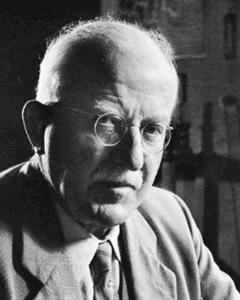- Hermann Staudinger
Infobox_Scientist
name=Hermann Staudinger

birth_date = birth date|1881|3|23
birth_place = Worms,Grand Duchy of Hesse ,German Empire
death_date = death date and age|1965|9|8|1881|3|23
death_place =Freiburg ,Germany
nationality =Germany
field =Chemistry
alma_mater =University of Halle
work_institution =University of Strasbourg University of Karlsruhe ETH Zürich University of Freiburg
doctoral_advisor =Daniel Vorländer
doctoral_students =Lavoslav Ružička
known_for =Polymer chemistry
prizes =Nobel Prize in Chemistry
religion =Hermann Staudinger (
March 23 ,1881 –September 8 ,1965 ) was a German chemist who demonstrated the existence ofmacromolecules which he characterized aspolymers . For this work he received the 1953Nobel Prize in Chemistry. He is also known for his discovery ofketenes and of theStaudinger reaction .Early work
Hermann Staudinger was born in 1881 in
Worms, Germany . After receiving his Ph.D. from theUniversity of Halle in 1903, Staudinger took a position at theUniversity of Strasbourg . .In 1907, Staudinger began an assistant professorship at the Technical University of Karlsruhe where he successfully isolated a number of useful organic compounds (including a synthetic coffee flavoring) as more completely reviewed by Mülhaupt.cite journal
author=Mülhaupt, R.
journal=Angew. Chem. Int. Ed.
title=Hermann Staudinger and the Origin of Macromolecular Chemistry
year=2004
volume=43
pages=1054–1063
doi=10.1002/anie.200330070]The Staudinger reaction
In 1912, Staudinger took on a new position at the
Swiss Federal Institute of Technology inZurich, Switzerland . One of his earliest discoveries came in 1919, when he and colleague Meyer reported thatazides react withtriphenylphosphine to formphosphazide (Figure 2).cite journal
author = Staudinger, H.; Meyer, J.
journal =Helv. Chim. Acta
title = Über neue organische Phosphorverbindungen III. Phosphinmethylenderivate und Phosphinimine
year = 1919
volume = 43
pages = 635–646
doi = 10.1002/hlca.19190020164] This reaction – commonly referred to as theStaudinger reaction – produces a high phosphazide yield.cite journal | author=Breinbauer, R.; Kohn, M. | journal=Angew. Chem. Int. Ed. | year=2004 | volume=43 | pages=3106–3116 | title=The Staudinger Ligation - A Gift to Chemical Biology | doi=10.1002/anie.200401744]Polymer chemistry
While at Karlsruhe and later, Zurich, Staudinger began research in the chemistry of
rubber , for which very high molecular weights had been measured by the physical methods of Raoult and van 't Hoff. Contrary to prevailing ideas (see below), Staudinger proposed in a landmark paper published in 1920 that rubber and other polymeric substances such asstarch ,cellulose andproteins are long chains of short repeating molecular units linked bycovalent bonds .cite journal | author = Staudinger, H. | journal =Ber. Deut. Chem. Ges. | year = 1920 | volume = 53 | pages = 1073 | doi = 10.1002/cber.19200530627 | title = Über Polymerisation] In other words, polymers are like chains of paper clips, made up of small constituent parts linked from end to end (Figure 3).At the time leading organic chemists such as Emil Fischer and
Heinrich Wieland .cite journal | author = Feldman, S. D.; Tauber, A. I. | journal =Bulletin of the History of Medicine | year = 1997 | volume = 17(4) | pages = 623–650 | doi = 10.1353/bhm.1997.0178 | title = Sickle Cell Anemia: Reexamining the First "Molecular Disease"] believed that the measured high molecular weights were only apparent values caused by the aggregation of small molecules intocolloids . At first the majority of Staudinger’s colleagues refused to accept the possibility that small molecules could link together covalently to form high-molecular weight compounds. As Mülhaupt aptly notes, this is due in part to the fact that molecular structure and bonding theory were not fully understood in the early 20th century.Further evidence to support Staudinger’s hypothesis emerged in the 1930s. High molecular weights of polymers were confirmed by membrane osmometry, and also by Staudinger’s measurements of
viscosity in solution. TheX-ray diffraction studies of polymers byHerman Mark provided direct evidence for long chains of repeating molecular units. And the synthetic work led by Carothers demonstrated that polymers such asnylon andpolyester could be prepared by well-understood organic reactions.Legacy
Staudinger’s groundbreaking elucidation of the nature of the high-molecular weight compounds he termed "Makromoleküle" paved the way for the birth of the field of polymer chemistry.cite journal | author = Staudinger, H. | journal =
Trans. Faraday Soc. | year = 1933 | volume = 29 | pages = 18–32 | doi = 10.1039/tf9332900018 | title = Viscosity investigations for the examination of the constitution of natural products of high molecular weight and of rubber and cellulose] Staudinger himself saw the potential for this science long before it was fully realized. “It is not improbable,” Staudinger smartly commented in 1936, “that sooner or later a way will be discovered to prepare artificial fibers from synthetic high-molecular products, because the strength and elasticity of natural fibers depend exclusively on their macro-molecular structure – i.e., on their long thread-shaped molecules.”cite journal | author = Staudinger, H. | journal =Trans. Faraday Soc. | year = 1936 | volume = 32 | pages = 323–335 | doi = 10.1039/tf9363200323 | title = The insoluble polystyrene] Staudinger founded the first polymer chemistry journal in 1940,cite journal | author = Meisel, I.; Mülhaupt, R. | journal =Macromolecular Chemistry and Physics |doi =10.1002/macp.200290078 | title = The 60th Anniversary of the First Polymer Journal (“Die Makromolekulare Chemie”): Moving to New Horizons | year = 2003 | volume = 204 | pages = 199] and in 1953 received the Nobel Prize in Chemistry for “his discoveries in the field of macromolecular chemistry.” [http://nobelprize.org/chemistry/laureates/1953/index.html The Nobel Prize in Chemistry 1953] (accessed Mar 2006).] His pioneering research has afforded the world myriad plastics, textiles, and other polymeric materials which make consumer products more affordable, attractive, and fun.See also
*
Heidegger and Nazism Notes
References
*cite journal
title= Hermann Staudinger and the Future of Polymer Research Jubilees - Beloved Occasions for Cultural Piety
author=Helmut Ringsdorf
journal= Angewandte Chemie International Edition
pages= 1064–1076
volume= 43
issue= 9
year= 2004
doi= 10.1002/anie.200330071
*cite journal
title= Hermann Staudinger 1881-1965
author= Heinrich Hopff
journal=Chemische Berichte | pages= XLI
volume= 102
issue= 5
year= 1969
doi= 10.1002/cber.19691020502External links
* Staudinger's [http://nobelprize.org/nobel_prizes/chemistry/laureates/1953/staudinger-bio.html Nobel Foundation biography]
* Staudinger's Nobel Lecture [http://nobelprize.org/nobel_prizes/chemistry/laureates/1953/staudinger-lecture.pdf Macromolecular Chemistry]
* [http://acswebcontent.acs.org/landmarks/polymer/life.html Staudinger’s life and career] .
Wikimedia Foundation. 2010.
